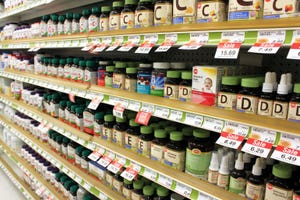Anti-aging ingredients—or “healthy aging” ingredients, as may be a more accurate term based on market trends—often target specific health concerns including heart health, brain health and cognition, bone and joint health, skin health and eye health.
July 23, 2018

According to the latest “The State of Aging and Health in America” report by the U.S. Centers for Disease Control and Prevention (CDC), longer life spans and the aging Baby Boomer demographic are the key factors contributing to growth of the aging population. The number of those ages 65 and older is expected to double by 2030 to amount to roughly 72 million, which is 20% of the total U.S. population. The United Nations predicted one in six people globally will be over age 60 by 2030, compared to one in eight people over age 60 in 2015. By 2050, the prediction rises to one in every five people.
As the body ages, its cells and communication systems become less balanced and efficient, which leads to greater production of free radicals and increased signaling of inflammatory cytokines and, thus, deterioration of cells and tissues. “This, in turn, can greatly influence noticeable qualities like brain acuity, vision, pain and skin integrity, and also make conditions more favorable for cancer or chronic inflammation, the precursor to the majority of disease states,” said Melanie Bush, chief science director, Artemis International.
Tryggvi Stefánsson, science manager, Algalif, further emphasized the relationship between aging, free radical production and health. “Younger people are naturally better protected from free radicals and other reactive oxygen species (ROS) through balanced activity of the mitochondria, efficient antioxidant and DNA repair systems, and active protein degradation machinery,” he said. “Aging, on the other hand, is generally accompanied by mitochondrial dysfunction leading to increased free radical production that, in turn, leads to an overloading of the defense systems and oxidative damage of cellular components.”1 Stefánsson noted several health concerns affecting seniors and mediated by oxidative stress and imbalances between pro-oxidants, such as ROS, and antioxidants, including oxidation of blood lipids (cholesterol and triglyceride),2 pain and stiffness in joints,3 cognitive decline,4 age-related ocular diseases5 and skin changes such as thinning of skin layers, loss of elasticity and function of oil glands, and accumulation of pigments.6
Anti-aging ingredients—or “healthy aging” ingredients, as may be a more accurate term based on market trends—often target specific health concerns including heart health, brain health and cognition, bone and joint health, skin health and eye health.
Healthy hearts
For the aging population, heart health is especially critical. The American Heart Association (AHA) estimated 15.9 million deaths caused by heart disease among those ages 70 and older—along with 11.4 million among those ages 30 to 69—could be delayed or prevented in 2025 if targets aimed at reducing salt intake and tobacco and alcohol use, managing obesity, and lowering blood pressure and glucose levels are met.
A recent study by the Mayo Clinic found intake of docosahexaenoic acid (DHA) and eicosapentaenoic acid (EPA) omega-3s helped reduce risk of coronary heart disease (CHD), especially among people in higher risk populations, such as those with high low-density lipoprotein (LDL, or “bad”) cholesterol.7
Astaxanthin, which is generally commercially derived from Haematococcus pluvialis microalgae, is a potent antioxidant offering heart healthy effects, among other benefits. In healthy, postmenopausal women with high-levels of oxidative stress, natural astaxanthin (12 mg/d for eight weeks) significantly decreased lower limb vascular resistance, a measure of functioning of the circulatory system.8 Additionally, astaxanthin at doses of 12 and 18 mg/d significantly reduced triglycerides, while 6 and 12 mg/d doses significantly increased high-density lipoprotein (HDL, or “good”) cholesterol in a randomized, placebo-controlled trial of 61 subjects with fasting serum triglyceride levels between 120 and 200 mg/dl.9
A blend of tomato phytonutrients (as Lycomato™, from Lycored) supported cardiovascular health via supporting healthy circulation,10 maintaining healthy blood pressure within normal range11,12 and boosting the body’s own protection mechanisms against oxidative stress, while reducing levels of clinically relevant biomarkers such as C-reactive protein (CRP)—commonly used to track cardiovascular condition. A standardized tomato nutrient complex (as Cardiomato™, from Lycored) reduced oxidized LDL cholesterol after two weeks of supplementation in a double-blind, placebo-controlled study of 150 healthy subjects.13
A meta-analysis of seven randomized, controlled trials published in 2017 indicated the potential of the botanicals turmeric and curcumin to improve serum lipid levels in patients at risk of cardiovascular disease (CVD).14 Specifically, research showed the ability of turmeric and curcumin to lower triglycerides and LDL cholesterol, though no effect on HDL cholesterol was seen.
Vitamin K2 has become a rising star in the heart health arena, especially for women in later stages of life. Vitamin K2 (as MenaQ7®, from NattoPharma) improved arterial stiffness in 244 healthy, postmenopausal women administered 180 µg of MenaQ7/d for three years.15 Arterial stiffness is a concern for women supplementing with calcium, which can lead to calcification and hardening of the arteries, known as atherosclerosis.
Also supporting women, French maritime pine bark extract (as as Pycnogenol®, from Horphag Research) reduced and normalized elevated cardiovascular risk factors including cholesterol, triglycerides, blood pressure and blood glucose in an eight-week study of 70 women ages 40 to 50, while also reducing peri-menopause symptoms such as hot flashes, night sweats and irregular periods.16
Brain power
“One of the most significant areas of health impacted by aging is cognition,” said Tom Druke, director of VitaCholine brand development, Balchem Human Nutrition and Pharma. He pointed to the Natural Marketing Institute’s (NMI) 2015 Healthy Aging Study, which showed “losing brain capacity” was the No. 1 age-related fear.
As a precursor of the neurotransmitter acetylcholine, choline assists the brain in sending messages throughout the body via the nervous system. In a recent study, supplemental choline in the form of choline bitartrate significantly improved accuracy by making modest reductions in speed as compared to the control group when administered a straightforward aim and click task on a computer.17 “This suggests that choline may play an important role in mental sharpness and focus for tasks requiring both speed and attention to detail,” Druke said.
In a double-blind, placebo-controlled study, astaxanthin (as AstaReal®) improved clarity of thinking, concentration, motivation and mood, while reducing irritation and feelings of body heaviness.18 Participants were subjected to a battery of timed calculations requiring intense concentration as well as a physical challenge performed using a bicycle ergometer. Visual analogue scale (VAS) analysis showed astaxanthin significantly reduced perceived symptoms of mental and physical fatigue compared to the placebo. In the calculation test, an increase in errors observed in the placebo during the second half of the test was almost eliminated in the astaxanthin group. Supplementation with astaxanthin also significantly reduced salivary cortisol, a biomarker for stress. Magnesium is an essential cofactor for more than 300 systems that regulate biochemical reactions in the body, including brain and nervous system function,19 explained Samantha Ford, new business development director, AIDP. AIDP’s patented compound of magnesium (Magtein®) raised the brain’s magnesium levels,20 and demonstrated significant increases in brain synaptic density with supplementation that returned to original levels within two weeks of stopping supplementation.21 In a randomized, double-blind, placebo-controlled trial, Magtein supplementation for 12 weeks resulted in significant improvements in memory, stress and anxiety in middle-aged and older adults.22
Deanne Dolnick, science director at TR Nutritionals, pointed to bacopa extract standardized to 20 percent bacosides for brain health for its anti-inflammatory effect23 and potential to repair damaged neurons in the brain.24
Bones & joints
Preserving bones and joints is critical to staying active in later years.
In healthy, postmenopausal women without recurring joint pain, eggshell membrane (as NEM®, from Stratum Nutrition) at a dose of 500 mg/d prevented breakdown of cartilage and improved recovery from exercise-induced joint pain.25Collagen type II derived from avian sternum (as KollaGen II-xs™, from AIDP) was effective at reducing joint pain and improved range of motion and muscle strength in a 30-day, randomized, controlled trial.26 In addition to collagen, the ingredient provides chondroitin, glucosamine and hyaluronic acid (HA)—the major components of joint cartilage.
Supplementation with low molecular weight HA (as Injuv®, from Soft Gel Technologies Inc.) improved joint mobility and pain associated with age or arthritis in an unpublished clinical trial conducted in Japan in 96 women ages 22 to 65. These results were in addition to the ingredient’s benefits to skin health, including improvements in skin moisture, smoothness and firmness. “Unfortunately, HA synthesis declines as we age,” said Steve Holtby, president and CEO, Soft Gel Technologies Inc., adding Injuv’s low molecular weight allows it to be absorbed and move to its target sites within the body.
In men and women ages 45 to 90 with OA, supplementation with methylsulfonylmethane (MSM as OptiMSM®, from Bergstrom Nutrition) improved WOMAC (Western Ontario and McMaster Universities) Osteoarthritis Index scores overall, and for physical function and stiffness compared to placebo.35 WOMAC scores improved with OptiMSM supplementation in a later trial of 100 patients with hip and/or knee OA, as well.27
To support bone, a proprietary combination of collagen and calcium (KoAct®, from AIDP) was proven superior to calcium and vitamin D in slowing down the leaching of calcium from bones, and led to significant improvements in markers of bone synthesis in a randomized, controlled trial of post-menopausal women.28
The ability to retain muscle mass is critically important in later life, especially as sarcopenia—degradation of skeletal muscle—has been linked to bone fragility in seniors and, specifically, increased risk of hip fracture in both men and women over age 65.29
Research published in 2016 found French maritime pine bark extract (as Pycnogenol), may be effective in curbing muscle loss that occurs with aging—a natural process that leads to sarcopenia.30 In an eight-week study of participants ages 70 to 78 and exhibiting signs of muscle loss, 150 mg Pycnogenol led to greater muscular function and endurance in daily tasks, among other benefits. Collagen peptides may also support muscle maintenance, according to Lisette van Lith, global director, Peptan®, who pointed to research showing the role of collagen peptides in preserving lean muscle mass and increasing muscle strength in older adults.31
Skin support
“In recent years there is growing interest in ingestible skin care and appreciation that true beauty starts from the inside,” said Karin Hermoni, Ph.D., head of science and nutrition, Lycored. “Our physical and emotional wellbeing are all reflected in the way our skin looks at any age and, specifically, as we age.”
Lindsey Carnett, CEO and president of Marketing Maven, pointed to market data from Statista showing the United States is a key market in the global skin care and cosmetics industry, generating an estimated revenue of approximately US$62 billion in 2016. She cited product launches and the “dominance of digital media” as drivers propelling the anti-aging industry into new territories, with “consumers wanting and expecting formulations that contain active ingredients backed by clinical research.”
Among trends noted by Carnett are use of boosted actives and toxin-free ingredients, as well as products featuring “clean beauty,” pollution-fighting positioning, bone broth, probiotics, collagen and bio-hacking, which “explores human biology, and finds ways to exploit certain practices or ingredients for increased health and wellness.”
Several ingredients support the need for active, clinically supported ingredients for healthy skin.
A proprietary tomato nutrient complex (as Lycoderm™, from Lycored) was shown to protect human skin against ultraviolet (UV) radiation in a double-blind, placebo-controlled, crossover study.32
Astaxanthin (as AstaReal) inhibited inflammation-mediated skin deterioration, including wrinkle formation and seasonal skin moisture decline, therefore preventing progression of skin aging, in a study of 65 females ages 35 to 60.33
Water-soluble eggshell membrane (WSEM, as BiovaDerm from Biova) reduced wrinkle depth when applied topically on facial skin in an eight-week study involving 20 healthy females ages 45 to 65.34 Researchers suggested the results may be related to WSEM’s ability to protect from free radical damage at the cellular level, among other mechanisms. Stauber is the exclusive distributor of Biova products.
Healthy aging trends, innovation
According to Euromonitor International, healthy living is one of eight megatrends shaping consumer markets in the years to come. According to Irina Barbalova, global lead, and Hannah Symons, beauty and fashion research, Euromonitor, prevention, when it comes to aging and health, is being seen across age groups. Younger consumers are pursuing prevention over treatment strategies when it comes to aging.
Understanding older consumers is key to reaching this demographic, the duo suggested. Older consumers continue to make societal contributions as caregivers or as part of the workforce, but are largely undervalued and underrepresented as a consumer group, and have specific needs to address.
According to the 2017 Supplement Over-the-Counter Rx Data (SORD) study commissioned by Lonza Consumer Health & Nutrition, older generations are most likely to use supplements, with 76% of boomers and 83% of matures taking a form of supplementation. “However, these consumer groups both also state that their supplements, such as traditional tablets, are sometimes difficult to swallow—34% of boomers and 30% of matures share this view,” said Barri Sigvertsen, Marketing Manager, Lonza. “As such, dosage forms that are easier to swallow may help improve and encourage usage. Ready-to-drink beverages, sprinkles/powders that can be added directly to food or drinks, gummies and capsules are all attractive dosage forms.”
Simplified supplement regimens may also appeal to older consumers, Sigvertsen suggested. Lonza’s survey indicated 33% of Generation X respondents and 22% of boomers surveyed feel they have to take too many supplements to get the nutrients they need, while 38% of all supplement users want to reduce their daily intake. “A solution for supplement manufacturers is to use dosage forms that combine ingredients, such as a two-in-one, capsule-in-capsule delivery system, to help reduce pill burden and simplify consumers’ supplementation routines,” he said.
Review of intellectual property (IP) indicates innovations containing natural product ingredients are directed to mitigating age-related disorders. Looking to patent applications, attorney Andreas Baltatzis, director, and Gideon Eckhouse, senior associate, KramerAmado PC, noted applications directed to healthy aging innovations has been relatively consistent since 2001, averaging about 130 applications per year. “However, it appears application filing peaked in 2012 and is on a downward trend if 2016 is an indicator of the future,” the duo explained.
A review of trademark applications showed the term “wellness” appears in goods nearly three times more often than in company name. The term “age” or “aging” appears almost 10 times more. During the last five years, the terms “age” or “aging” have been used 77 times, Eckhouse and Baltatzis explained. The consistent use of the terms “age” or “aging” in the last 20 years “indicates a consistent trend,” they noted. “Brand owners have realized the value of these terms in conveying their products will help meet the needs of aging consumers.”
Information for the article was excerpted from INSIDER’s “Healthy living: Optimizing life with supplements and nutrition” Digital Magazine. Read more about healthy aging ingredients, trends and innovation by downloading the issue.
For a list of references, email [email protected].
About the Author(s)
You May Also Like






.png?width=800&auto=webp&quality=80&disable=upscale)